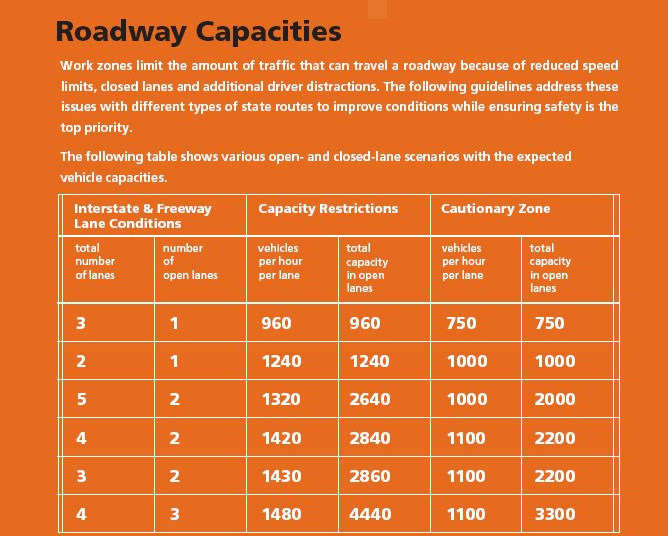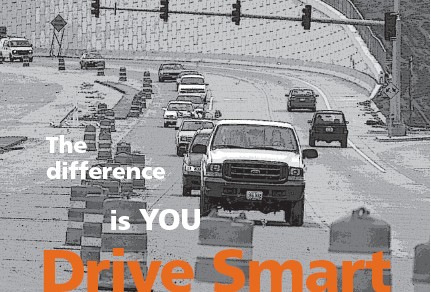616.25 MoDOT Work Zone Guidelines
The guidelines focus on safety, communication and convenience by:
- Shifting work to night and off-peak hours, when possible.
- Setting appropriate speed limits.
- Providing effective communication about upcoming projects and alternate routes.
Work Zone Analysis
Four key strategies are used to impact work zones for highway workers and motorists.
1. Use appropriate and consistent work zone speed limits to reflect actual conditions
- Guidelines promote proper posting and clarify DOT and driver expectations.
- Speed-limit reductions are removed when conditions change (i.e., lane closure removed, workers not present, etc.).
- Appropriate warning signs are used for specialized safety considerations (i.e., curves, lane width, etc.).
2. MoDOT and contractors’ staff work during off-peak hours as appropriate and determined by the engineer,
- Hourly volume tables are used to determine when to work off-peak hours.
- Staff use off-peak work-hour guidelines when scheduling lane closures.
- Nighttime or weekend work may be required, as necessary.
- Some night work activities present unique challenges. An assessment should be made in advance of planned nighttime work to determine if that activity should be conducted during daylight hours and a proper communication plan developed to alert motorist of delays.
- Consider statewide effects of special events along major routes.
3. Planning for Contractor and MoDOT workforce safety
- 3.1 Some work activities should be performed during daytime due to visibility, staffing or other concerns. The following are examples of these types of work. The following list of activities is not all inclusive.
- i). Bridge:
- (1) Annual bridge inspections with Snooper
- (2) Off-system bridge inspections
- (3) Emergency Bridge Repairs
- i). Bridge:
- ii). Maintenance:
- (1) Mowing – Visibility is essential to avoid obstacles such as culverts, signposts, and hitting debris.
- (2) Vegetation Trimming- Visibility is important since workers are on foot and may be using equipment such as weed eaters, grinding brushes or chain saws.
- (3) Herbicide Applications – same as mowing.
- (4) Pipe Replacements – Moving equipment, working in excavated areas and overhead lifting all need high visibility.
- (5) Litter Removal – Visibility is important for slip, trip and fall hazards to prevent falls. This activity would be difficult to provide lighting on a moving operation.
- (6) Sweeping – Moving operations are not conducive to advance warning signs because vehicles are constantly in motion.
- (7) Patching / Potholes
- ii). Maintenance:
- iii). Construction
- (1) Complex activities having many moving parts.
- (a) Girder Installation.
- (b) Bridge Deck Removal / Demolition.
- (1) Blasting Operations.
- (3) When materials aren’t available at night:
- (4) Surveying.
- (1) Complex activities having many moving parts.
- iii). Construction
- iv). Traffic
- (1) Emergency Signal or Light Repair – Could be day or night. Planned work might need daytime.
- (2) Tube Counters– Typically daytime installation.
- (3) Engineering type work – Typically observing or conducting off the roadway.
- (4) Sign Log inspections must be performed at night – Required to do at night to account for retro-reflectivity of signs.
- iv). Traffic
- 3.2 The following daytime or nighttime work should be considered when considering the need for daytime or nighttime work:
- i) What activity are we performing:
- (1) What is the complexity of the task?
- (a) How many people are involved?
- (b) What types of equipment are involved?
- (c) How is the material being delivered to the project?
- (i) Does the material require escort or over-dimension permit?
- (ii) Does the material need to be staged if working nights?
- (d) What is the duration of the task?
- (i) Will it involve one shift?
- (ii) Will it require longer hours than available at night?
- (iii) Is there a logical break point to divide the work periods?
- (2) Identify the areas of concern.
- (a) What risks are inherent to this type of work?
- (b) How can we mitigate these areas of concern and still work at night?
- (3) Is good visibility required to safely perform the task? If the answer is yes, can we provide enough lighting for the task to be performed at night? (See paragraph iv – Can we effectively light the work zone.)
- (4) Can we mitigate the impacts to traffic with other methods?
- (a) Can we perform the work during non-peak daytime hours?
- (b) Can we perform the work on weekends?
- (c) Have other methods been used with success?
- (1) What is the complexity of the task?
- i) What activity are we performing:
- ii) Availability of Workers to perform the assigned tasks. Impacts MoDOT, contractors and vendors.
- (1) What are the number of workers required to perform the work safely?
- (a) Do we have these numbers?
- (i) Do we need to combine crews to perform the task?
- (ii) Do we have enough supervision?
- (iii) Can we split crews and maintain presence for other emergency response needs?
- (a) Do we have these numbers?
- (2) Are there alternative methods to work during off peak hours?
- (a) Can we group nighttime work to one time period?
- (b) Can we work outside of peak hours such as 9 am to 3pm?
- (c) Can we work weekends if necessary to have daytime and adjust the work week?
- (d) Can we work overtime with approval to increase efficiency? (Get in and get out)
- (1) What are the number of workers required to perform the work safely?
- ii) Availability of Workers to perform the assigned tasks. Impacts MoDOT, contractors and vendors.
- iii) Consider Criminal Activities.
- (1) Identify areas where crime occurs repeatedly.
- (2) Is it safer to work daytime hours when crime is not an issue?
- (3) Consider impact of drive by shootings and law enforcement pursuits, rolling gun battles.
- iii) Consider Criminal Activities.
- iv) Can we effectively illuminate the work zone?
- (1) What type of work is being performed? Can we effectively and safely perform the work at night?
- (2) Can we provide lighting for flaggers, workers, work locations and equipment without blinding or confusing the traveling public.
- (3) Is the equipment available?
- (a) Do we have the equipment or need to rent it?
- (b) Do we have personnel trained to operate the equipment?
- (4) Need to develop a lighting plan
- (a) Consider location of the lighting.
- (i) How much lighting do we need to effectively illuminate the work areas?
- (ii) How do we orient the lighting to prevent blinding on-coming traffic?
- (iii) What type of lighting do we need?
- (b) What happens if a light plant goes down? Do we have a backup?
- (c) Do we have a fueling plan for continuous operations?
- (d) Consider technology such as balloon lighting for equipment and work areas.
- (e) Consider lighting transition sections such as crossovers, traffic shifts, key intersections.
- (5) Add alternative solutions for Maintenance of Traffic (MOT) that have been utilized with success to the EPG. All alternatives rely heavily on available routes, type of traffic, robust communication plans and coordination with internal and external customers. These are not all inclusive and other ideas should be considered during the core team process or maintenance planning process and incorporated into the MOT.
- (a) Consider location of the lighting.
- iv) Can we effectively illuminate the work zone?
- v) Close the road completely and push traffic away from the work.
- (1) Benefits
- (a) Removes traffic from work area.
- (b) Increases efficiency of work performed.
- (c) Eliminates the need for additional protective barrier for closed lane.
- (d) Eliminates adding additional shoulder reinforcement or reducing lanes.
- (2) Examples of Work:
- (a) Utilized for bridge replacements in Rural Areas.
- (b) Other Examples:
- (i) Shut Down Traffic on I-44 for a Bridge Demo in Springfield.
- 1. Closed interstate and forced traffic to route down JRF and back up Rte. 65
- 2. Developed a robust Communication Plan.
- 3. Included all Emergency Services to include Civil Air Patrol.
- (ii) Closed US 65 in Springfield to rebuild Roadway in Springfield.
- 1. Mostly Commuter Traffic.
- 2. Numerous bypass routes.
- 3. Required a robust Communication Plan.
- 4. Relied on commuter traffic to find their own way.
- (i) Shut Down Traffic on I-44 for a Bridge Demo in Springfield.
- (3) Other considerations:
- (a) Do we have a network that could support this reroute?
- (i) Do we have an outer road system?
- (ii) Is there a public network system that is available?
- (iii) What type of traffic do we have? Commuters or Thru Traffic?
- (b) Do we need to provide a signed detour?
- (i) Does it need to be on static signs?
- (ii) Can we use CMSs? Usually depends on complexity of detour and number of turning locations.
- (c) Can traffic find its own way around without a detour? Commuter traffic has adequate notice and plan for alternate routes.
- (d) Do we have availability of an Intelligent Transportation System to reroute traffic when certain thresholds are met (stopped or slowed traffic)?
- (e) Can we utilize Law Enforcement to assist with queues?
- (f) May have issues with emergency services accessing the area of an emergency that requires access. Must plan for alternate routes.
- (a) Do we have a network that could support this reroute?
- (1) Benefits
- v) Close the road completely and push traffic away from the work.
- vi) Running Traffic Up and Over the Ramp at a Diamond Interchange?
- (1) Benefit:
- (a) Removes traffic from work area.
- (b) Increases efficiency of work performed.
- (c) Eliminates the need for additional protective barrier for closed lane.
- (d) Eliminates adding additional shoulder reinforcement or reducing lanes.
- (e) Emergency services have better access to area in case of emergency on the project and better ability to respond to incidents not relating to the project.
- (2) Examples of Work:
- (a) Use to rebuild pavement or perform maintenance operations between the ramps on mainline or perform active work over the highway.
- (b) Used on I-44 Pavement Rebuild at Selmore Road near Springfield.
- (c) Used on I-70 Pavement Rebuild in Columbia.
- (3) Identify duration of work – Long term vs. short term:
- (a) Short Term - Can the work be performed at night or over a weekend? Less impactful since performed during lower peak times.
- (b) Long Term – Traffic impacts to lanes during peak times
- (i) Can the ramps handle the amount of traffic?
- (ii) Can we increase the ramp capacity to allow all lanes of traffic to divert onto the ramp?
- (iii) Can we close access to ramps from side streets to keep the ramp traffic running continuously?
- (iv) Can we divert traffic to multiple locations?
- (1) Benefit:
- vi) Running Traffic Up and Over the Ramp at a Diamond Interchange?
- vii) Close ramps to traffic.
- (1) Benefits:
- (a) Removes traffic from the work area.
- (b) Increases efficiency of work performed.
- (c) Eliminates the need for additional protective barrier for closed lanes.
- (2) Examples of Work:
- (a) Maintenance operations such as pothole patching, pavement repair, and sign installations.
- (b) Repair or pavement replacement.
- (c) Repair lighting.
- (3) Are there alternate routes available?
- (4) Can they utilize the next interchange to provide access or double back to the interchange?
- (5) Do you have multiple lanes on the ramp? Is it safe to allow traffic access to the open lane?
- (1) Benefits:
- vii) Close ramps to traffic.
- viii) Close Secondary Roadways, Lower Volume Routes, and Commuter Routes – Short- Term closures for 1 day.
- (1) Benefits:
- (a) Increase efficiency.
- (b) Safer for workers.
- (2) Examples of Work:
- (a) Use for seal coats, pipe replacements, patching, sweeping, debris removal, etc.
- (b) Other short-term operations.
- (3) Local traffic – message boards and communication through news releases and social media.
- (4) Over-dimension coordination.
- (5) Availability of non-peak daytime hours or weekends.
- (1) Benefits:
- viii) Close Secondary Roadways, Lower Volume Routes, and Commuter Routes – Short- Term closures for 1 day.
- ix) Traffic Pacing (Rolling Roadblocks).
- (1) Benefits:
- (a) Provides positive control of traffic to prevent access to the site while performing short term work.
- (b) Utilizes Law Enforcement to slow traffic – respected by traffic.
- (2) Challenges:
- (a) May require blocking multiple interchanges and personnel.
- (b) Need distance between interchanges.
- (3) Calculate distance based on time frame needed to perform the work.
- (4) Examples of work:
- (a) Used for moving traffic control phase changes or moving barrier.
- (b) Bridge work such as girder and panel installation over traffic.
- (c) Short term pavement or maintenance repairs.
- (1) Benefits:
- ix) Traffic Pacing (Rolling Roadblocks).
- x) Coordinate all activities required in an area (Maintenance, Traffic and Construction)
- (1) Benefits:
- (a) One work zone set up for multiple agencies or contractors.
- (b) Provide JSPs in Contracts to require the contractor to allow other forces within their work zone.
- (2) Examples:
- (a) Allowing maintenance to perform operations in the work zone to avoid conflict with the contractor (sweeping, patching, striping, etc.
- (b) Maintenance activities can be let as contractor projects.
- (1) Benefits:
- x) Coordinate all activities required in an area (Maintenance, Traffic and Construction)
4. Quality control and quality assurance measures in work zones
- Lane drops are removed, when no longer needed.
- Work zone traffic-control devices placed properly.
- Ensure all work zone traffic-control devices are kept clean, repaired or replaced when necessary and have adequate reflectivity.
Statewide Work Zone Coordinator
The statewide work zone coordinator organizes lane closures and oversees work zones on the National Highway System so traffic runs smoothly, safely and effectively with the least amount of inconvenience to motorists. Responsibilities include:
- Coordinating lane closures across district boundaries and across the state
- Considering the statewide impact of work zones to traffic
- Ensuring the statewide traffic effects of major sporting events, the state fair and other special activities are considered when planning work zones
District Work Zone Coordinators
Each of MoDOT’s seven districts have a work zone coordinator to organize lane closures within their district, and ensure work zones in their area run smoothly, safely and effectively with the least amount of inconvenience to motorists. Each district engineer supports the work zone coordinators and ensures they implement these guidelines internally and externally. District work zone coordinator responsibilities include:
- Scheduling lane closures during off-peak and/or nighttime hours when possible, when traffic volumes exceed 75 percent to 80 percent of the open-lane capacity
- Scheduling work on multiple projects on the same route
- Working with Project Development to ensure that working days for projects requiring lane closures will be reduced, when possible
- Notifying the statewide work-zone coordinator before any lane closures on the National Highway System
- Using hourly volume tables to determine if lane closures will result in capacity traffic levels in the open lanes
- Collecting all proposed roadway project work from district staff
- Reviewing all maintenance and internal work zone activities requiring lane closures
- Reviewing all commercial and utility/permit work zone activities requiring lane closures
Project Award
Before any project is awarded, the project core team will review it to ensure MoDOT is taking the appropriate actions to reduce work zone effects on the public. The project manager will conduct traffic analyses to ensure the following actions minimize traffic impacts:
- Scheduling lane closures during off-peak and/or at nighttime hours, when possible
- Using incentive/disincentive contracting and other bidding options, when possible, to reduce project completion time
- Evaluating and implementing schedules to reduce the number of working days needed to complete projects quicker
- Using road closures and/or signed detours, when possible, to complete projects quicker
- Opening additional through lanes to reduce traffic effects
- Ensuring work zone speed limits are appropriate in active and non-active work zones
MoDOT Roadway Maintenance and Activities
The district work zone coordinator reviews all maintenance and internal work zone activities requiring lane closures to reduce the work zone effects on motorists. The district engineer ensures the appropriate district staff considers the following actions when scheduling lane closures:
- Notifying the district work zone coordinator 48 hours before beginning any non-emergency work requiring a lane closure
- Scheduling lane closures during off-peak and/or nighttime hours, when possible
- Ensuring work zones are maintained in a neat, orderly and effective manner for the safety of highway workers and motorists
- Scheduling multiple tasks in a single work zone, rather than scheduling multiple lane closures in the same area
- Making every effort to minimize traffic backups
- Ensuring the appropriate traffic-control equipment is used
- Ensuring work zone speed limits are appropriate in active and non-active work zones
Commercial Utility/Permit Work
The district work zone coordinator reviews all commercial and utility or permit projects to reduce work zone effects on motorists. The permit staff ensures the following actions are considered:
- Notifying the district work zone coordinator 48 hours before any work requiring a lane closure begins
- Scheduling lane closures during off-peak and/or nighttime hours, when possible
- Inspecting all work zones and ensuring traffic-control plans are implemented, or work will halt
- Ensuring work zones are maintained in a neat, orderly and effective manner for the safety of highway workers and motorists
- Scheduling multiple tasks in a single work zone, rather than scheduling multiple lane closures in the same area
- Making every effort to minimize traffic backups
- Ensuring work zone speed limits are appropriate in active and non-active work zones
Active Construction-Project Work Zones
The appropriate MoDOT resident engineer reviews all active construction work zones. The district engineer ensures the following actions are taken:
- Notifying the district work zone coordinator in accordance with contract specifications before any work requiring a lane closure begins
- Working with the contractor to ensure lane closures are minimized
- Making every effort to minimize traffic backups
- Ensuring all contract specifications, special provisions and work restrictions are enforced
- Ensuring all work zones are neat, orderly and effective for the safety of highway workers and motorists
- Ensuring work zone speed limits are appropriate in active and non-active work zones
| Least amount of delay to the motorist |
|---|
Roadway Capacities
- Hourly Volume Tables
- To obtain hourly volume tables, contact the district work zone coordinator.
- Keep Missouri Moving Safely in Work Zones
- You can help reduce the number of those injured and killed in work zone crashes.
- Plan your trip. Contact MoDOT for lane closure information.
- Stay alert.
- Drive courteously.
- Obey work zone sings and flaggers' instructions.
- Be patient. Work today results in smoother roads tomorrow.
Interstates and Freeways
Interstates and freeways are high volume multiple-lane routes divided by medians. These routes carry the largest volumes of traffic, and depending on the number of lanes, can affect thousands of vehicles per hour. By using the appropriate work zone guidelines on these roadways, the biggest work zone improvements can be made. The Highway Capacity Manual provides traffic-capacity information for urban freeway work zones. This information may also be used for rural freeways and interstates.
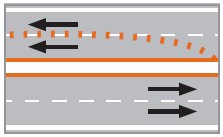
The most common interstate and freeway work zone situation in Missouri is on a route with two lanes per direction, with one closed lane. This results in a maximum traffic capacity of 1,240 vehicles per hour. Strategies to reduce effects on the motoring public should be considered when traffic volumes approach 1,000 vehicles per hour per lane.
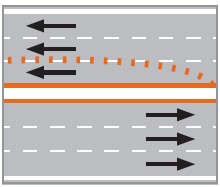
Where there are three lanes in one direction and one is closed, or where there are four lanes with one or two of those closed, the open-lane capacity is approximately 1,450 vehicles per hour. Strategies to reduce effects on the motoring public should be considered when traffic volumes approach 75 percent of the restricted capacity, or 1,100 vehicles per hour. Where there are three lanes in one direction and two are closed, the maximum capacity is approximately 960 vehicles per hour and strategies should be considered when traffic volumes approach 750 vehicles per hour per lane.
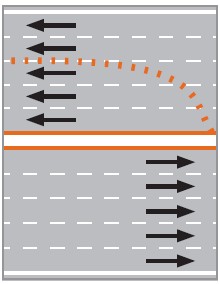
The greatest traffic reductions per lane occur when the situation is most restricted. For instance, if there are five lanes in one direction and three are closed, the capacity of the two open lanes is 1,320 vehicles per hour per lane. Strategies to reduce effects on the motoring public should be considered when volumes approach 75 percent of the restricted capacity, or 1,000 vehicles per hour per lane.
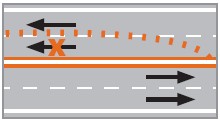
Multilane Roadways
Multilane roadways also have more than one lane per direction, however, because most do not have medians, they must be treated differently than interstates and freeways.
The work zone capacity of multilane roadways is approximately 1,000 vehicles per hour per lane. Strategies to reduce effects on the motoring public should be considered when volumes approach 80 percent, or 800 vehicles per hour per lane.

Two-lane Roadways
Work zones for two-lane roadways need to be reviewed on a case-by-case basis. Although these routes have the lowest traffic volumes, they also do not have medians and may have narrower shoulders and more curves than higher-volume routes.
Strategies to reduce effects on the motoring public should be considered when volumes approach 600 vehicles per hour per lane.
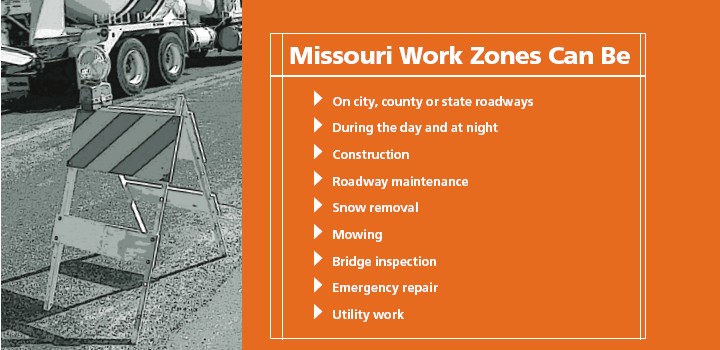
Roadway Capacities
